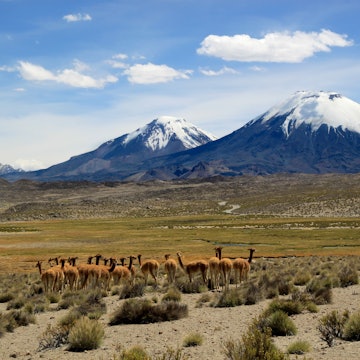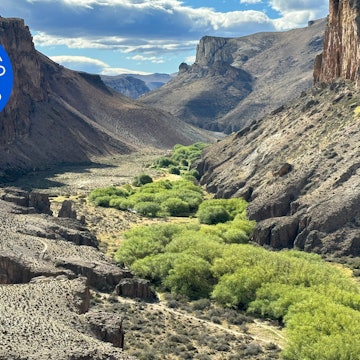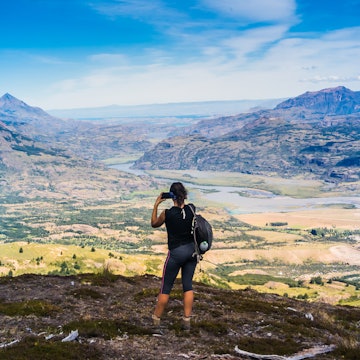

Stepping into (or climbing up) Argentina’s stunning landscapes is the stuff hikers dream of © Dudarev Mikhail / Shutterstock
From the high Andes to subtropical rainforests, from arid valleys to ice fields, Argentina’s stunning countryside is a playground for trekkers of all abilities.
In such legendary locations as Parque Nacional Los Glaciares and Parque Nacional Nahuel Huapi, you can test yourself against some of the most dramatic topography on the planet.
Most trails in Argentina run through national parks or reserves, which often have well-marked routes and facilities such as campsites and cabins – ideal for those who like to trek under their own steam without joining an organized trek. Of course, some of the more challenging trails are best attempted with a local guide to help steer you through this unforgiving terrain.
Whether you fancy a short, relaxed walk or a challenging multi-day trek, there are options for all levels of fitness and interest. Here are seven of the best hikes in Argentina.
Quebrada de Humahuaca
Best hike for dramatic scenery
Distances vary, half-day to one day, moderate
In the far northwest of Argentina, close to the border with Bolivia, the Quebrada de Humahuaca is a geologically rich mountain valley that stretches for some 155km (96 miles). The terrain here is dramatic and sometimes otherworldly: think deep canyons and ravines, thundering rivers and pastel-shaded mountainsides formed from layers of mineral-rich rocks ranging in color from dark brown and deep purple to pale pink and creamy white.
Named a Unesco World Heritage Site in 2003, the Quebrada is also home to diverse cultures, with tranquil villages and towns that have retained a strong Indigenous character. There are plenty of hiking routes in the region, some following trails laid down by Inca people centuries ago linking ancient ruins and archaeological sites. Hire a local guide to get a deeper understanding from the experience.

Paseo Superior
Best option for accessible hiking
1.9km (1.1 miles), 1–3 hours, easy
Overlooking the world’s most beautiful set of waterfalls, Parque Nacional Iguazú is one of the most accessible reserves in Argentina, with well-designed, relatively short and largely flat trails that mostly follow boardwalks and bridges. This is a walking destination for almost anyone, from kids to older travelers.
The Paseo Superior cuts through lush, subtropical forest and provides great views over the top of a series of waterfalls. And it’s entirely wheelchair accessible, as is the bulk of the 1.4km (0.8-mile) Paseo Inferior. The latter takes you lower and closer to the cascades – so close, in fact, you may well get a tad moist as you make your way along the path.

Cerro Aconcagua
Best hike if you’re up for a challenge
40km (24.8 miles), 13–15 days, hard
The ascent of Cerro Aconcagua – the tallest mountain in the western hemisphere, located 112km (70 miles) northwest of the city of Mendoza in Argentina’s midwest – makes it onto our list because you don’t need to have technical climbing skills to follow the Northwest (or “Normal”) route to the summit.
However, Aconcagua shouldn’t be taken lightly. Hikers must be super-fit, undertake sufficient training and, ideally, have prior experience of trekking at high altitudes. It’s vital to join an organized tour with a well-established tour company, allowing at least 13 (and up to 15) days in total, allowing you to fully acclimatize before heading toward the summit.
Unpredictable weather often scuppers attempts to reach the 6962m (22,841ft) summit, known as the “roof of the Americas.” But if you make it, the sense of satisfaction is immense. As are the bragging rights.

Parque Nacional Nahuel Huapi
Best for overnight hikes
Distances vary, 1–3 days, moderate
Covering a gorgeous swathe of the Lake District, one of the most visited regions in Argentina, Parque Nacional Nahuel Huapi has numerous campsites and trekking lodges known as refugios, making it an excellent place for a multi-day hike.
For example, four different trails climb through patches of scree and dense forests to the 2388m (7835ft) summit of Cerro Catedral. A popular ski resort in the winter, the peak is home to Refugio Emilio Frey, where you can get a warm meal and a cozy bunk for the night.
Meanwhile, the two-day Paso de Las Nubes (“Pass of the Clouds”) trail travels through meadows, across rivers, into forests of lenga trees and around limpid lakes. After an overnight stay at Refugio Agostino Rocca, you can retrace your route or connect to another trail – linking short trails into longer walks is part of the fun of trekking at Parque Nacional Nahuel Huapi.

Laguna de los Tres
Best for solo hiking
20km (12.4 miles), one day, moderate
Thanks to a well-maintained network of clearly marked, interlinked trails, it’s easy to explore the northern sector of Parque Nacional Los Glaciares in southwest Patagonia without a guide.
The Laguna de los Tres hike is one of the most popular and memorable routes. Starting in the frontier village of El Chaltén, the trekking and climbing capital of Argentina, this rewarding trail winds past waterfalls, lakes, meadows and beech forests. The hike finishes at the eponymous lagoon, which sits at the base of – and acts as a mirror for – looming Cerro Fitz Roy.
From here you can head back to El Chaltén or continue via the Lagunas Madre y Hija trail to the similarly impressive Laguna Torre, where you can camp overnight.

Glaciar Perito Moreno
Best hike for aspiring polar explorers
Distances vary, half-day, easy
For anyone who dreams of emulating polar explorers such as Robert Falcon Scott, Ernest Shackleton and Roald Amundsen, an ice hike on the Glaciar Perito Moreno provides a taste of what it’s like to strike out across Antarctica.
After entering the southern sector of Parque Nacional Los Glaciares, you’ll take a boat across a lake dotted with icebergs, before you strap on a pair of crampons to get ready to climb onto the tip of a 250 sq km (96.5 sq mile) sweep of blue-white ice. As you walk past cracks, fissures and caves, the glacier will creak, groan and shudder as if it was alive. Occasionally, a great roar will sound as a house-sized chunk of ice calves off the edge and plunges into the waters below. You don’t get that on every hike...

Parque Nacional Tierra del Fuego
Best option for day hikes
Distances vary, half-day to one day, easy to moderate
At the southernmost tip of Argentina, Parque Nacional Tierra del Fuego is a wild expanse of sticky bogs, thick beech forests, windswept tundra, crystalline lakes and pebble beaches. A short drive from the city of Ushuaia, the park has several easy-to-navigate trails that can be completed in a day or less.
Popular routes include the 3km (1.8-mile) Senda Hito XXIV, which leads to the border with Chile and the 5km (3.1-mile) hike up Cerro Guanaco, whose 970m (3182ft) summit offers superb views of Lago Roca. If you want something longer, there’s the 8km (4.9-mile) Senda Costera, which traces the shorelines of Ensenada and Lapataia Bays.
Whichever trail you choose, keep your eyes peeled for birds: the park is home to Magellanic woodpeckers, austral parakeets and green-backed firecrown hummingbirds, among many other species.
















